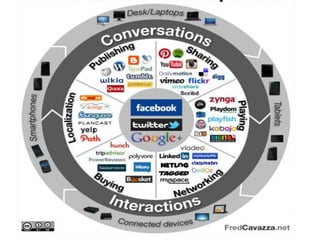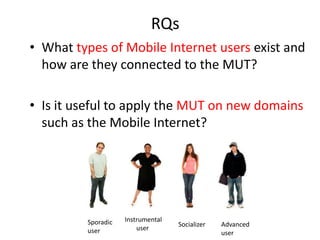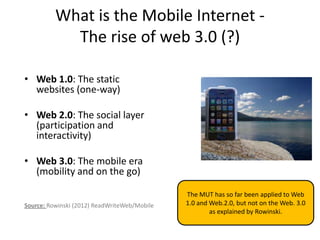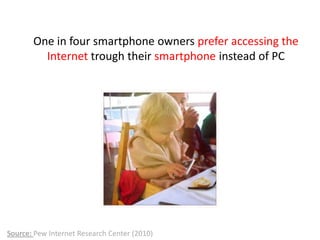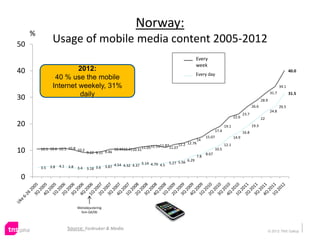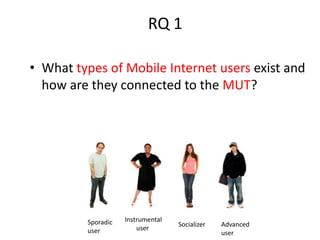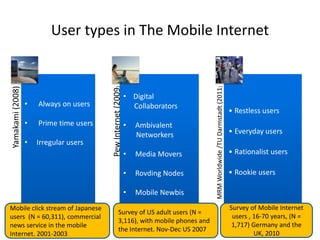User types of the Mobile Internet
- 1. MUT and the Mobile Internet: Applying the approach to other domains Petter Bae Brandtzæg Trial Lecture, 10th of August, 2012 University of Oslo IMK
- 2. Outline of this presentation • MUT • The research questions • The Mobile Internet • Usage patterns of the Mobile Internet versus usage patterns on PC • Mobile Internet Trends • Media-user types in the Mobile Internet • Findings and conclusions • Future research
- 3. MUT • What? MUT = Media-User Typology • How? To classify diverse users of new media into user types based on their typical usage pattern • Why? In order to achieve a better understanding of the users and how they differ in their participation in new media
- 5. It's therefore harder than ever to understand how users differ in their participation in new media.
- 6. MUT - user types classified How often is it according to four factors used? Frequency of use Is it being used for many different purposes? Media Variety of User type platform use Which media platform are used (i.e., SNSs, blogs or the Internet in Content general)? preferences What is the core activity ?
- 7. MUT – a user typology approach An initial unified Media-User Typology – MUT and the four criteria defining type by media behaviour User type Frequency Variety of Content preferences (core Media Platform of use use activity) (1) Non-users No No No All (2) Sporadics Low Low No particular activity, irregular All (3) Lurkers Medium Low Passive consumption, lurking, SNSs and new time-killing media in general (4) Entertainment users Medium Medium Gaming, watching videos All (5) Socializers Medium Medium Socializing with friends, family SNSs and acquaintances (6) Instrumental users Medium Medium Utility oriented, work related, All egov services (7) Debaters Medium Medium Discussion and information Blogs and SNSs exchange (8) Advanced users High High All (gaming, shopping, All programming, socializing, egov services) Source: Brandtzæg, P. B. (2010). Towards a unified Media-User Typology (MUT): A meta-analysis and review of the research literature on media-user typologies. Computers in Human Behavior, 26(5), 940–956.
- 8. A review and analysis of existing user typologies (22) related to new media usage, in order to reach a unified user typology An empirical investigation of SNS user in Norway (N = 5,233) to reach a social networking sites typology A validation of SNS-user types and by using a longitudinal survey of online user over time (N = 2,001/age range: 15-75 years, in three annual waves (2008, 2009, and 2010) Norway A validation of Internet user types across countries by using a empirical investigation among citizens in Europe (Austria, Norway, Spain, Sweden and U.K.) (N = 12,666/age range: 16–74 years).
- 9. How can the MUT be used • To understand users • To understand the digital divide, in terms of user types rather than access versus no access/non-use versus use • To measure the social implications of different media usages (e.g. social capital) • To allow media developers to decide upon target groups (and to develop personas) in research and development at projects • To improve the user experience for specific user groups, by providing targeted services to users according to their specific user type.
- 10. RQs • What types of Mobile Internet users exist and how are they connected to the MUT? • Is it useful to apply the MUT on new domains such as the Mobile Internet? Sporadic Instrumental Socializer Advanced user user user
- 11. What is the Mobile Internet - The rise of web 3.0 (?) • Web 1.0: The static websites (one-way) • Web 2.0: The social layer (participation and interactivity) • Web 3.0: The mobile era (mobility and on the go) The MUT has so far been applied to Web Source: Rowinski (2012) ReadWriteWeb/Mobile 1.0 and Web.2.0, but not on the Web. 3.0 as explained by Rowinski.
- 12. With the Mobile Internet – Internet is "everywhere"
- 13. The always-on is the classic assumption in the mobile computing. The mobile handsets are workable at any- time, any-place (Yamakami, 2008, p.571) Source: Yamakami, T. (2008). A User-Perceived Freshness Clustering Method to Identify Three Subgroups in Mobile Internet Users. International Conference on Multimedia and Ubiquitous Engineering
- 14. The Mobile Internet • The Mobile Internet is about accessing the web over a mobile device (tablet, mobile phone) • Is the Internet used differently from accessing it on PC?
- 15. PC vs. Mobile • Stationary location (e.g. • On the go in diverse work or at home) contexts • Directed and shorter (e.g. • Less directed and longer finding facts) (e.g. browsing) • Shorter emails/messages • Longer emails/messages • Extend and complement PC-usage Data from Google search logs reveald that users' iPhone searching behaviour are more similar to PCs compared to previouse-generation mobile phones (Kamvar et al., 2009). Source: Tossel, Rahmati & Lin (2012) Characterizing Web use on Smartphones, CHI2012
- 16. One in four smartphone owners prefer accessing the Internet trough their smartphone instead of PC Source: Pew Internet Research Center (2010)
- 17. Context – mobility • Travelling - movement between places • Wandering - movement within a place • Visiting - the act of being in one place for a limited amount of time Context driven user engagement? Source: Kristoffersen S, Ljungberg F (1999), Mobile use of IT. Twenty-second information systems research seminar in Scandinavia
- 19. The Mobile Internet is about: • Real-time, context-driven interactive engagement (e.g., context sensitive services) • "Always on" –where the boundaries between the “real” and the “digital” are blurred
- 20. To day the real world and information are more or less seperated
- 21. In the near future the mobile Internet will connect things and people Tracking, monitoring and controlling
- 22. But who and how many are using the Mobile Internet?
- 23. 10 percent Worldwide, the mobile Internet accounts for 10% of total Internet usage in 2012 (increased from 4% in 2010, because of the growing adoption of smartphones and tablet devices) Source: Pingdom – using data from StatCounter http://royal.pingdom.com/2012/05/08/mobile-web-traffic-asia-tripled/ The data for 2012 covers the first seven days of May, 2012 http://gs.statcounter.com
- 24. Norway: % 50 Usage of mobile media content 2005-2012 Every Ukentlig week 40 2012: 40.0 40 % use the mobile Daglig day Every Internet weekely, 31% 34.1 30 daily 31.7 31.5 28.9 26.6 26.5 24.8 23.7 22.6 22 20 19.1 19.3 17.4 16.8 15.07 14.9 14 11.5311.87 12.2 12.76 12.1 10.5 10.6 10.5 10.8 10.2 10.4410.4110.3111.05 11.07 10 9.22 9.11 9.46 8.67 10.5 7.8 6.29 5.14 4.79 4.5 5.27 5.56 3.5 3.8 4.1 3.8 3.4 3.18 3.6 3.87 4.54 4.32 4.37 0 Metodejustering fom Q4/06 Source: Forbruker & Media © 2012 TNS Gallup
- 25. Weekely usage of content on mobile devices 60 år + 7 More younger people access content on mobile weekely 40 - 59 år 34 20 - 39 år 63 12 - 19 år 64 Kvinne 36 44% males and 36% females access content on mobile at Mann 44 least weekely Total 40 % 0 10 20 30 40 50 60 70 Source: Forbruker & Media. Q1 2012. www.tns-gallup.no/medier © 2012 TNS Gallup
- 26. What kind of apps do people access? 543 million people logged in to Facebook by using a mobile device in June 2012 (Facebook stats, 2012) Source: The figure are taken from a Nielsen Company white paper from the AppNation conference California 2010. based on survey data from August 2010. US mobile subscribers.
- 27. RQ 1 • What types of Mobile Internet users exist and how are they connected to the MUT? Sporadic Instrumental Socializer Advanced user user user
- 28. User types in The Mobile Internet Pew Internet (2009) MRM Worldwide /TU Darmstadt (2011) Yamakami (2008) • Digital • Always on users Collaborators • Restless users • Prime time users • Ambivalent Networkers • Everyday users • Irregular users • Media Movers • Rationalist users • Rovding Nodes • Rookie users • Mobile Newbis Mobile click stream of Japanese Survey of Mobile Internet Survey of US adult users (N = users (N = 60,311), commercial users , 16-70 years, (N = 3,116), with mobile phones and news service in the mobile 1,717) Germany and the the Internet. Nov-Dec US 2007 Internet. 2001-2003 UK, 2010
- 29. Yamakami (2008) Pew Internet (2009) 38% MRM/TU (2011) MUT of the user motivated by mobility Always on users Digital collaborators (8%). Restless users (10%): Advanced users Actively engaged in Mostly males, late 30s, Younger users, always on, High use and high variety of mobile web all day, always on, create and share uses a range of different use, all media platforms broad usage content services (smallest group) Ambivalent networkers (7%), Everyday users (25%): Socializers Late 20s, social networking, Younger adults, uses mobile Medium use, medium information etc. social media everyday and variety, socializing with added features friends, family etc. (SNSs) Media movers (7%), Male Entertainment users mid 30, gaming and sharing Medium use, medium photos variety, mainly gaming and video consumption Prime time users Rovding nodes (9%), women The Rationalist (50%): Uses Instrumental users Particular user specific late 30s, using email and mobile Internet regular, Utility oriented, often work behaviour patterns in basic apps selective usage, few added related. Organized and day-scale features purposeful use Irregular users Mobile newbis (8%), 50s, The Rookie (15%): Low usage Sporadics Randomly visits mobile novice users, safety, keep in intensity, few basic services. Low use and low variety of webs touch (rarely mobile internet) 45 years +, Nokia use. No particular activity, irregular.
- 30. RQ 2 • Is it useful to apply the MUT on new domains such as the Mobile Internet? YES: Five (six) of the user types in the MUT corresponded with user types identified in the Mobile Internet. Debaters, Lurkers are not identified. There was either not identified any specific Mobile Internet user type Sporadic Instrumental Socializer Advanced user user user
- 31. Finding and conclusions (1) • MUT: It's useful to apply the MUT on new domains such as the Mobile Internet • NON-USERs: is to be found in the Pew Study – which accounts for 62% of the US. population. The majority of users are lagging behind. • ALWAYS ON: Few users are "always on" even if this is the classic assumption of the mobile Internet • DIGITAL DIVIDE AND SOCIAL CAPITAL: The user types reflects large variations in user participation (inequalities) in the Mobile Internet – and as a results describe differences in how people enrich their social networks and information access.
- 32. Finding and conclusions (2) • DESIGN: The user types represent not only different behavior patterns, but also differences in preferences and user needs, which should be used as input to the design of new mobile Internet services targeting different user types • MUT: The existing user typologies in the Mobile Internet have been shown to connect well to the MUT, but rapid evolution in the Mobile Internet could make it difficult to develop long-term stable user types in this domain
- 33. Future research • There is a need for more detailed analysis of the different user types in the Mobile Internet. This is a relatively unexplored in the literature, due to the fact that this is a fairly new domain and the development is fast (e.g. no user type research in Africa and Asia) • Future research should investigate if there is a faster migration to more advanced user types in the Mobile Internet compared to other domains (e.g. PC usage) • There is a need, also, in the domain of the Mobile Internet for a unified typology. All the user typologies used different methods and labels. Applying the MUT-approach in future research could be a useful solution. • Finally, - how will the Mobile Internet of things affect usage patterns of the Mobile Internet in the future?
Editor's Notes
- Web. 1.0 – the medium is themessageWeb. 2.0. – the medium is thesocialmessageWeb. 3.0. – the medium is boththesocial and the mobile message
- InternetThe focus on the "always on" feature with the mobile Internet have neglected the diversity that there are non-always-onusers in the mobile Internet. Google……"We think Glass helps you share your life as you’re living it; from life’s big moments to everyday experiences"
- As the mobile Internet is one of the major way to access the web, it is important for researchersto identify the mobile Internet behaviors (Yamakami, 2008, p. 557). Studies suggest that when Africans go online (predominantly with their mobile phones) they spend much of their time on social media platforms (Facebook, Twitter, YouTube and so on. The widespread availability of mobile phones means that the mobile Web can reach tens of millions more than the wired Web."
- Pew Internet found that cell phone app downloaders were younger, more educated, had higher incomes, tended to live in urban and suburban areas The Nielsen Global Online Consumer Confidence Survey, established in 2005, tracks consumer confidence, major concerns and spending intentions among more than 31,000 Internet consumers in 56 countries. Consumer confidence levels above and below a baseline of 100 indicate degrees of optimism and pessimism
- Sample: A representative sample of adult users (N = 3116), only people using mobile phones and the Internet. November-December 2007.Analysis: Cluster analysis – reached a solution of 9 clusters, 5 covering users of mobile phones (not necessary the mobile Internet)Measures: Inputs for this typology: assets, actions (how they use it) and attitudes. The Rookie (15%): Low usage intensity. The mobile web is being used selectively and is still reduced to a few, very basic services. 45 years +, only user type where the majority are using Nokia. (Similar to Sporadics)2. The Rationalist (50%): Using mobile Internet on a regular basis. Very selective usage, few added features. 25-45 years old (Similar to Instrumentalist) 3. The Everyday (25%): Use the mobile web often and are also using the added features, such as social media. However, their mobile web usage is no real competition to their usage of their PC. 55% are not older than 34 years. (Similar to Socializers) 4. The Restless (10%): Smallest group. High usage intensity, uses a range of different services and the value the mobile web is offering. Extensive usage of social media and magazines. 70% younger than 34 years old. (Similar to Advanced users)




